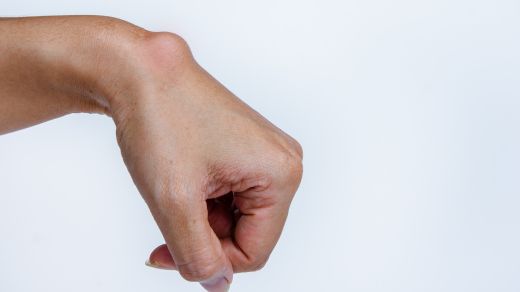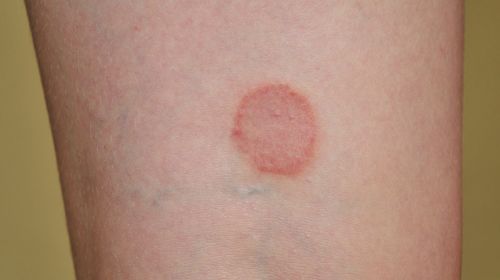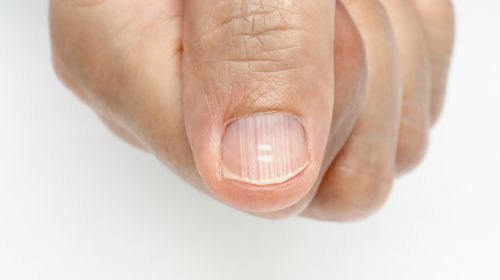If a thickening suddenly forms on the wrist or foot, this is colloquially referred to as overleg. Find out what exactly a ganglion is, how it develops and whether it can cause problems.
- © Getty Images/AboutnuyLove
Quick overview: ganglion
Look: A ganglion looks like a ball under the skin and usually forms near joints, especially the wrists. This bump usually does not cause any discomfort, but can be slightly painful when pressure is applied.
Therapy: A ganglion often disappears on its own. In some cases, a puncture can also be made to suck out the fluid. The spherical cyst can also be removed using surgical procedures.
Causes: A ganglion can have various causes. Examples include joint trauma (for example due to injuries), joint diseases (osteoarthritis, gout) or overuse.
Article content at a glance:
What is a ganglion?
A ganglion is a benign, fluid-filled swelling or cyst on a joint capsule or tendon sheath. The swellings can occur in different sizes and are usually round or oval in shape.
A wrist ganglion most often forms on the back of the hand. Other parts of the body where a ganglion can occur include:
- finger
- shoulder
- Kneel
- Feet
- Hip
- Spine
Ganglia always originate from a joint or tendon. These are surrounded by fluid and connective tissue – the joint capsule or tendon sheath – for protection. If the connective tissue weakens, a protrusion or tumor can form that fills with fluid and becomes visible and palpable on the surface of the skin. The ganglion remains connected to the joint capsule or tendon sheath via a stalk and can continue to fill with fluid.
As it progresses, the swelling can become increasingly solid and even hard as bone. For this reason, the term “overleg” is also used colloquially, as a change in the bone is often incorrectly assumed to be the cause of the swelling.
Überbein: definition of the term from other diseases
The term “overleg” is primarily used colloquially as a synonym for ganglion. But the term is also used for other types of growths in the bones and joints, for example for the so-called exostosis.
An exostosis is a usually benign bony tumor that develops from solid bone substance. The exostoses include, for example, Haglund’s heel – a bony growth on the heel bone. This is also colloquially known as overleg.
How common is a ganglion and who is affected?
Ganglions occur relatively frequently. About half of all benign soft tissue swellings in the hand are ganglia. However, there is no exact information as to how many people are generally affected. In principle, overleg can occur at any age, even in children. Women seem to be affected more often than men.
Causes: Why does a ganglion form?
The exact causes of the formation of an overleg have not yet been clarified. However, weak connective tissue can promote its development. In addition, other risk factors are suspected that can contribute to the formation of ganglia. These include:
Injuries: Repeated microinjuries or traumatic injuries to joints, ligaments or tendons can cause a ganglion to develop.
Joint diseases: People with joint diseases such as osteoarthritis, rheumatism or gout are more likely to develop ganglia.
Overuse: Certain activities or occupations that require repetitive movements or high stress on the joints may increase the risk of ganglia. One-sided activities can also promote the development of a ganglion.
What does a ganglion look like?
The appearance of overleg can vary:
Ganglia usually range from about the size of a pea to a few centimeters in diameter.
They are plump and often still elastic at the beginning. However, they cannot be moved or shifted.
The skin over a ganglion is usually normal. The color can also differ slightly from the surrounding skin and, for example, be slightly reddish.
Furthermore, there are no distinguishing features between the individual body regions. An overleg on the foot can look the same as an overleg on the wrist.
Does a ganglion cause problems?
Often a ganglion is just a cosmetic problem. In individual cases it can also cause symptoms such as:
Pain when putting pressure on the affected joint or area
Restricted movement of a joint or muscle when the ganglion presses on a tendon
Sensory disturbances, numbness or tingling if the swelling presses on nerves or blood vessels
Diagnosis of a ganglion
Most ganglia do not require treatment. They often go away on their own. If symptoms such as wrist pain or other impairments occur, those affected should seek medical advice.
To make a diagnosis, the doctor often only uses visual and tactile examinations to detect a ganglion. Further examinations such as an ultrasound or magnetic resonance imaging (MRI) are only very rarely necessary – usually to rule out other diseases.
Therapy of a ganglion
Treatment of the overleg can be carried out either conservatively or surgically. If the symptoms are minor, conservative therapies are particularly suitable
If necessary, the ganglion pain can also be relieved with Kinesio tape after consultation with a doctor.
Other treatment options include puncture of the above leg, also known as aspiration. To do this, the ganglion is pierced with a cannula and the synovial fluid is sucked out. The affected area is then immobilized with a pressure bandage for a few days. This procedure may need to be repeated several times to achieve lasting success.
Surgical treatment of an overleg
If the pain is very severe or if conservative therapies are unsuccessful, the overleg can also be removed surgically. The procedure is usually carried out under local anesthesia. Removing a ganglion can be done in two different ways: surgical and minimally invasive.
During surgical removal The joint capsule or tendon is exposed through a skin incision and the ganglion including the stalk is completely removed.
With the minimally invasive variant The ganglion is removed through four small skin incisions using arthroscopy (joint examination).
In both variants, the affected body part must be immobilized for a certain period of time. Patients are usually on sick leave for this period.
Prognosis: Can a ganglion recur?
In about 10 to 15 percent of cases, a ganglion can form again after surgery (recurrence). This especially happens if the ganglion has been incompletely removed. Regardless of this, overleg can also occur in any other part of the body.


